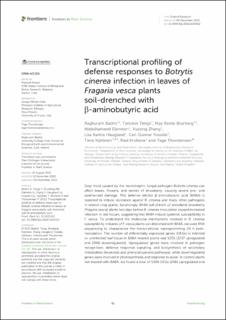| dc.contributor.author | Badmi, Raghuram | |
| dc.contributor.author | Tengs, Torstein | |
| dc.contributor.author | Brurberg, May Bente | |
| dc.contributor.author | Elameen, Abdelhameed | |
| dc.contributor.author | Zhang, Yupeng | |
| dc.contributor.author | Haugland, Lisa Karine | |
| dc.contributor.author | Fossdal, Carl Gunnar | |
| dc.contributor.author | Hytönen, Timo | |
| dc.contributor.author | Krokene, Paal | |
| dc.contributor.author | Thorstensen, Tage | |
| dc.date.accessioned | 2023-02-23T18:49:30Z | |
| dc.date.available | 2023-02-23T18:49:30Z | |
| dc.date.created | 2023-01-09T13:27:11Z | |
| dc.date.issued | 2022-12-08 | |
| dc.identifier.citation | Frontiers in Plant Science. 2022, 13 1-15. | en_US |
| dc.identifier.issn | 1664-462X | |
| dc.identifier.uri | https://hdl.handle.net/11250/3053693 | |
| dc.description.abstract | Grey mold caused by the necrotrophic fungal pathogen Botrytis cinerea can affect leaves, flowers, and berries of strawberry, causing severe pre- and postharvest damage. The defense elicitor β-aminobutyric acid (BABA) is reported to induce resistance against B. cinerea and many other pathogens in several crop plants. Surprisingly, BABA soil drench of woodland strawberry (Fragaria vesca) plants two days before B. cinerea inoculation caused increased infection in leaf tissues, suggesting that BABA induce systemic susceptibility in F. vesca. To understand the molecular mechanisms involved in B. cinerea susceptibility in leaves of F. vesca plants soil drenched with BABA, we used RNA sequencing to characterize the transcriptional reprogramming 24 h post-inoculation. The number of differentially expressed genes (DEGs) in infected vs. uninfected leaf tissue in BABA-treated plants was 5205 (2237 upregulated and 2968 downregulated). Upregulated genes were involved in pathogen recognition, defense response signaling, and biosynthesis of secondary metabolites (terpenoid and phenylpropanoid pathways), while downregulated genes were involved in photosynthesis and response to auxin. In control plants not treated with BABA, we found a total of 5300 DEGs (2461 upregulated and 2839 downregulated) after infection. Most of these corresponded to those in infected leaves of BABA-treated plants but a small subset of DEGs, including genes involved in ‘response to biologic stimulus‘, ‘photosynthesis‘ and ‘chlorophyll biosynthesis and metabolism’, differed significantly between treatments and could play a role in the induced susceptibility of BABA-treated plants. | en_US |
| dc.language.iso | eng | en_US |
| dc.publisher | Frontiers Media | en_US |
| dc.rights | Navngivelse 4.0 Internasjonal | * |
| dc.rights.uri | http://creativecommons.org/licenses/by/4.0/deed.no | * |
| dc.title | Transcriptional profiling of defense responses to Botrytis cinerea infection in leaves of Fragaria vesca plants soil-drenched with β-aminobutyric acid | en_US |
| dc.title.alternative | Transcriptional profiling of defense responses to Botrytis cinerea infection in leaves of Fragaria vesca plants soil-drenched with β-aminobutyric acid | en_US |
| dc.type | Peer reviewed | en_US |
| dc.type | Journal article | en_US |
| dc.description.version | publishedVersion | en_US |
| dc.rights.holder | © 2022 Badmi, Tengs, Brurberg, Elameen, Zhang, Haugland, Fossdal, Hytönen, Krokene and Thorstensen | en_US |
| dc.source.pagenumber | 15 | en_US |
| dc.source.volume | 13 | en_US |
| dc.source.journal | Frontiers in Plant Science | en_US |
| dc.identifier.doi | 10.3389/fpls.2022.1025422 | |
| dc.identifier.cristin | 2103288 | |
| dc.relation.project | Norges forskningsråd: 249958 | en_US |
| dc.source.articlenumber | 1025422 | en_US |
| cristin.ispublished | true | |
| cristin.fulltext | original | |
| cristin.qualitycode | 2 | |

